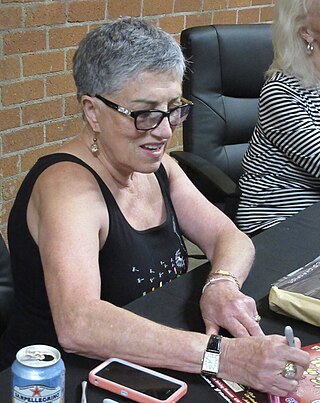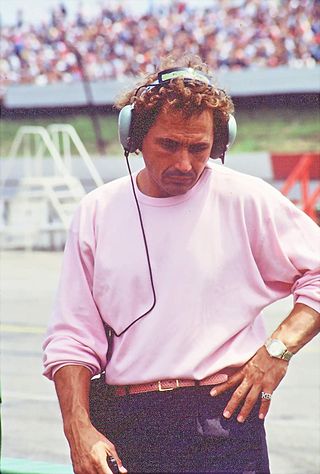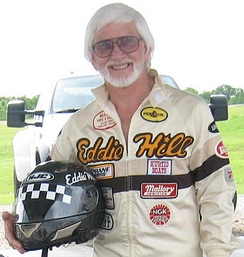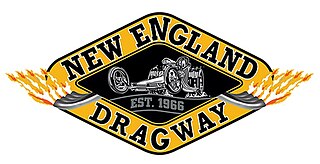
Drag racing is a type of motor racing in which automobiles or motorcycles compete, usually two at a time, to be first to cross a set finish line. The race follows a short, straight course from a standing start over a measured distance, most commonly 1⁄4 mi, with a shorter, 1,000 ft distance becoming increasingly popular, as it has become the standard for Top Fuel dragsters and Funny Cars, where some major bracket races and other sanctioning bodies have adopted it as the standard. The 1⁄8 mi is also popular in some circles. Electronic timing and speed sensing systems have been used to record race results since the 1960s.

The National Hot Rod Association (NHRA) is a governing body which sets rules in drag racing and hosts events all over the United States and Canada. With over 40,000 drivers in its rosters, the NHRA claims to be the largest motorsports sanctioning body in the world.

Donald Glenn Garlits is an American race car driver and automotive engineer. Considered the father of drag racing, he is known as "Big Daddy" to drag racing fans around the world. A pioneer in the field of drag racing, he perfected the rear-engine Top Fuel dragster, an innovation motivated by the loss of part of his foot in a dragster accident. This design was notably safer since it put most of the fuel processing and rotating parts of the dragster behind the driver. The driver was placed in front of nearly all the mechanical components, thus protecting him and allowing him to activate a variety of safety equipment in the event of catastrophic mechanical failure or a fire. Garlits was an early promoter of the full-body, fire-resistant Nomex driving suit, complete with socks, gloves, and balaclava.

Funny Car is a type of drag racing vehicle and a specific racing class in organized drag racing. Funny cars are characterized by having tilt-up fiberglass or carbon fiber automotive bodies over a custom-fabricated chassis, giving them an appearance vaguely approximating manufacturers' showroom models. They also have the engine placed in front of the driver, as opposed to dragsters, which place it behind the driver.

Top Fuel is a type of drag racing whose dragsters are the quickest accelerating racing cars in the world and the fastest sanctioned category of drag racing, with the fastest competitors reaching speeds of 338 miles per hour (544.0 km/h) and finishing the 1,000 foot (304.8 m) runs in 3.62 seconds.

Shirley Muldowney, also known professionally as "Cha Cha" and the "First Lady of Drag Racing", is an American auto racer. She was the first woman to receive a license from the National Hot Rod Association (NHRA) to drive a Top Fuel dragster. She won the NHRA Top Fuel championship in 1977, 1980, and 1982, becoming the first person to win two and three Top Fuel titles. She won a total of 18 NHRA national events.

Pro stock is a class of drag racing featuring "factory hot rods". The class is often described as "all motor", due to the cars not using any form of forced induction such as turbocharging or supercharging, or other enhancements, like nitrous oxide, along with regulations governing the modifications allowed to the engines and the types of bodies used.

Top Alcohol refers to two different classes in professional drag racing: Top Alcohol Dragster and the Top Alcohol Funny Car. Commonly known as "alky" cars, both are akin in design to the premier Top Fuel classes, but less powerful. In both classes, the cars are either supercharged ("blown") engines, burning alcohol (methanol) or can burn nitromethane and be normally aspirated, fuel injected engines. Top Alcohol Dragsters and Funny Cars resemble their nitromethane (Fuel) counterparts, with about half the power of their respective classes. Each car uses a three-speed transmission.

Kenneth Dale Bernstein is an American drag racer and former NASCAR and IndyCar team owner. He is nicknamed the "Bud King" for his success in the Budweiser King funny car and dragster. He has also been nicknamed the "King of Speed," because he was the first driver to break 300 miles per hour in the standing-start quarter mile. Bernstein owned King Racing, which he drove for in the NHRA and fielded various cars in other racing series such as IndyCar and NASCAR. Bernstein retired from full-time competition in 2002 and moved his son Brandon into the Bud King Top Fuel dragster, but returned to finish the season in place of his son after Brandon suffered a severe injury. With the exception of a brief return to Funny Car in 2007, Bernstein did not return to the car and instead continued to run his team until the end of the 2011 season when he left drag racing altogether.
Nostalgia drag racing is a form of drag racing using cars from the 1950s, 1960s and lately the 1970s.

Scotty Cannon is an innovator of drag racing in the Pro Modified class in the International Hot Rod Association (IHRA). He has won 28 International Hot Rod Association Pro Modified finals, competing in 45. Cannon has the most pro-modified victories as the Bristol Motor Speedway, with four.

Eddie Hill is an American retired drag racer who won numerous drag racing championships on land and water. Hill had the first run in the four second range (4.990 seconds), which earned him the nickname "Four Father of Drag Racing." His other nicknames include "The Thrill", "Holeshot Hill", and "Fast Eddie". In 1960, he set the NHRA record for the largest improvement in the elapsed time (e.t.) when he drove the quarter mile in 8.84 seconds to break the previous 9.40-second record.

Don Nicholson was an American drag racer from Missouri. He raced in the 1960s and 1970s when there were few national events. The National Hot Rod Association (NHRA) estimates he won 90 percent of his match races. As of 2002, he held the record for the most number of categories in which he reached a final round : Funny Car, Pro Stock, Super Stock, Competition Eliminator, Stock, and Street. He was nicknamed "Dyno Don" after he was one of the first drivers to use a chassis dynamometer on his cars in the late 1950s, a skill that he learned while working as a line mechanic at a Chevrolet car dealer.
Super Comp is the fastest of the heads-up Super classes. Super Comp is composed primarily of dragsters. Engine, chassis and body modifications are virtually unlimited, though all entries must adhere to NHRA or IHRA safety standards. Four and six-cylinder-powered entries may have a minimum weight of 1,000 pounds; all others cannot weigh less than 1,350 pounds.

Mendy Fry is an American dragster and funny car driver competing in the NHRA. Under the tutelage of her father, Ron, she began driving quarter-midget sprint cars at age 4. As a teenager, she campaigned in the NHRA Top Alcohol Dragster class. She is the only female drag racer to record a 5-second 1/4 mile elapsed time in a front-engined Top Fuel dragster, as well as the only female member of the exclusive "Nostalgia Top Fuel 250 mph Club". In 2019 she recorded the first 5.4 second quarter-mile elapsed time in a AA/Fuel Dragster.

Dale Armstrong was a Canadian drag racer and crew chief. After winning 12 National Hot Rod Association (NHRA) and 12 International Hot Rod Association (IHRA) events in the 1970s, including the Pro Comp title in 1975, he became Kenny Bernstein's crew chief. The combination produced four consecutive national championships in Funny Car and another in Top Fuel. Bernstein became the first driver to top the 300 miles per hour mark in an engine tuned by Armstrong. Armstrong has been inducted in numerous halls of fame. He died on November 28, 2014, at his home in Temecula, California, at the age of 73. He had sarcoidosis.

A gasser is a type of hot rod car originally used for drag racing. This style of custom car build originated in United States in the late 1950s and continued until the early 1970s. In the days before Pro Stock, the A/Gas cars were the fastest stock-appearing racers around.

New England Dragway is a 1⁄4 mile NHRA dragway in Epping, New Hampshire, Rockingham County, United States. The track hosts the New England Nationals event as part of the NHRA Camping World Drag Racing Series. The track also hosts a regional event as part of the NHRA Lucas Oil Drag Racing Series.

A dragster is a specialized competition automobile used in drag racing.
Altered is a former National Hot Rod Association (NHRA) drag racing class and a current drag racing chassis configuration that forms the basis of many classes of NHRA Competition Eliminator.




















